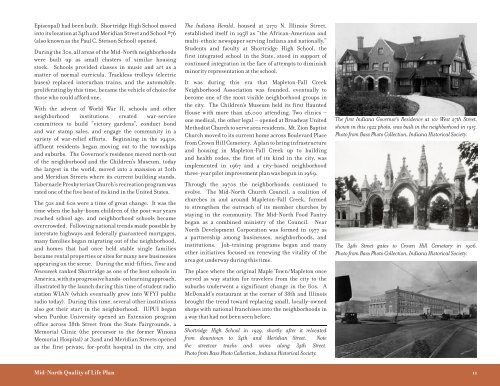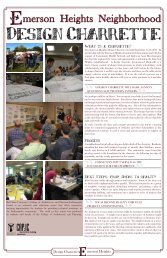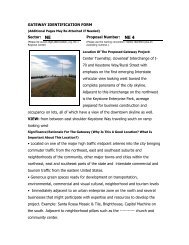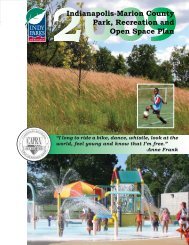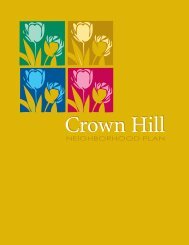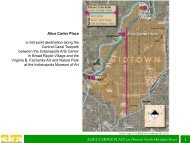Six Neighborhoods - City of Indianapolis and Marion County
Six Neighborhoods - City of Indianapolis and Marion County
Six Neighborhoods - City of Indianapolis and Marion County
- No tags were found...
You also want an ePaper? Increase the reach of your titles
YUMPU automatically turns print PDFs into web optimized ePapers that Google loves.
Episcopal) had been built. Shortridge High School movedinto its location at 34th <strong>and</strong> Meridian Street <strong>and</strong> School #76(also known as the Paul C. Stetson School) opened.During the 30s, all areas <strong>of</strong> the Mid-North neighborhoodswere built up as small clusters <strong>of</strong> similar housingstock. Schools provided classes in music <strong>and</strong> art as amatter <strong>of</strong> normal curricula. Trackless trolleys (electricbuses) replaced interurban trains, <strong>and</strong> the automobile,proliferating by this time, became the vehicle <strong>of</strong> choice forthose who could afford one.With the advent <strong>of</strong> World War II, schools <strong>and</strong> otherneighborhood institutions created war-servicecommittees to build “victory gardens”, conduct bond<strong>and</strong> war stamp sales, <strong>and</strong> engage the community in avariety <strong>of</strong> war-relief efforts. Beginning in the 1940s,affluent residents began moving out to the townships<strong>and</strong> suburbs. The Governor’s residence moved north out<strong>of</strong> the neighborhood <strong>and</strong> the Children’s Museum, todaythe largest in the world, moved into a mansion at 30th<strong>and</strong> Meridian Streets where its current building st<strong>and</strong>s.Tabernacle Presbyterian Church’s recreation program wasrated one <strong>of</strong> the five best <strong>of</strong> its kind in the United States.The 50s <strong>and</strong> 60s were a time <strong>of</strong> great change. It was thetime when the baby-boom children <strong>of</strong> the post-war yearsreached school age, <strong>and</strong> neighborhood schools becameovercrowded. Following national trends made possible byinterstate highways <strong>and</strong> federally guaranteed mortgages,many families began migrating out <strong>of</strong> the neighborhood,<strong>and</strong> homes that had once held stable single familiesbecame rental properties or sites for many new businessesappearing on the scene. During the mid-fifties, Time <strong>and</strong>Newsweek ranked Shortridge as one <strong>of</strong> the best schools inAmerica, with its progressive h<strong>and</strong>s-on learning approach,illustrated by the launch during this time <strong>of</strong> student radiostation WIAN (which eventually grew into WFYI publicradio today). During this time, several other institutionsalso got their start in the neighborhood. IUPUI beganwhen Purdue University opened an Extension program<strong>of</strong>fice across 38th Street from the State Fairgrounds, aMemorial Clinic (the precursor to the former WinonaMemorial Hospital) at 32nd <strong>and</strong> Meridian Streets openedas the first private, for-pr<strong>of</strong>it hospital in the city, <strong>and</strong>The Indiana Herald, housed at 2170 N. Illinois Street,established itself in 1958 as “the African-American <strong>and</strong>multi-ethnic newspaper serving Indiana <strong>and</strong> nationally.”Students <strong>and</strong> faculty at Shortridge High School, thefirst integrated school in the State, stood in support <strong>of</strong>continued integration in the face <strong>of</strong> attempts to diminishminority representation at the school.It was during this era that Mapleton-Fall CreekNeighborhood Association was founded, eventually tobecome one <strong>of</strong> the most visible neighborhood groups inthe city. The Children’s Museum held its first HauntedHouse with more than 26,000 attending. Two clinics –one medical, the other legal – opened at Broadway UnitedMethodist Church to serve area residents. Mt. Zion BaptistChurch moved to its current home across Boulevard Placefrom Crown Hill Cemetery. A plan to bring infrastructure<strong>and</strong> housing in Mapleton-Fall Creek up to building<strong>and</strong> health codes, the first <strong>of</strong> its kind in the city, wasimplemented in 1967 <strong>and</strong> a city-based neighborhoodthree-year pilot improvement plan was begun in 1969.Through the 1970s the neighborhoods continued toevolve. The Mid-North Church Council, a coalition <strong>of</strong>churches in <strong>and</strong> around Mapleton-Fall Creek, formedto strengthen the outreach <strong>of</strong> its member churches bystaying in the community. The Mid-North Food Pantrybegan as a combined ministry <strong>of</strong> the Council. NearNorth Development Corporation was formed in 1977 asa partnership among businesses, neighborhoods, <strong>and</strong>institutions. Job-training programs began <strong>and</strong> manyother initiatives focused on renewing the vitality <strong>of</strong> thearea got underway during this time.The place where the original Maple Town/Mapleton onceserved as way station for travelers from the city to thesuburbs underwent a significant change in the 80s. AMcDonald’s restaurant at the corner <strong>of</strong> 38th <strong>and</strong> Illinoisbrought the trend toward replacing small, locally-ownedshops with national franchises into the neighborhoods ina way that had not been seen before.Shortridge High School in 1929, shortly after it relocatedfrom downtown to 34th <strong>and</strong> Meridian Street. Notethe streetcar tracks <strong>and</strong> wires along 34th Street.Photo from Bass Photo Collection, Indiana Historical Society.The first Indiana Governor’s Residence at 101 West 27th Street,shown in this 1922 photo, was built in the neighborhood in 1915.Photo from Bass Photo Collection, Indiana Historical Society.The 34th Street gates to Crown Hill Cemetary in 1906.Photo from Bass Photo Collection, Indiana Historical Society.Mid-North Quality <strong>of</strong> Life Plan11


